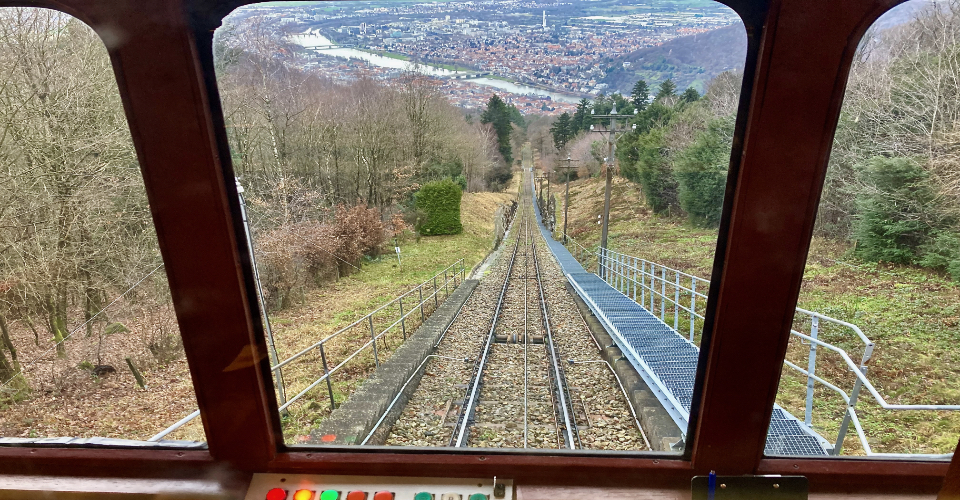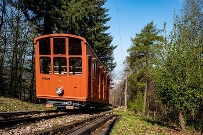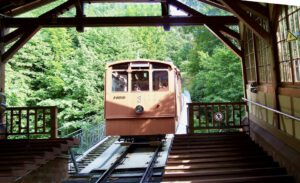
Heidelberger Bergbahnen
Heidelberg’s mountain railway system
The Heidelberg Mountain Railway, also known as Heidelberger Bergbahnen, is a combination of two funicular railroads. The “Molkenkurbahn” one of Germany’s most modern funicular railways, runs from the Kornmarkt on the edge of the old town up via the Heidelberg Castle station to the Molkenkur. From there the Königstuhlbahn, one of the oldest electrical funicular railways climbs on up to the Königstuhl, the town’s highest point at more than 550 metres.
The lower mountain railroad began operating on March 30, 1890. Today, over 133 years after its first official run, it is more than ever a tourist magnet: Around 1.8 million guests use the Heidelberg mountain railroads every year – the lower line, which has since been replaced by modern cars, and the upper “old lady” with the original over 100 years old cars, which have always been carefully maintained and during the past three decades have undergone painstaking renovations and restoration.
The History of a Heidelberg Landmark
” . . . Then as now: Good things come to those who wait . . . “
 The prehistory of the mountain railroad started in 1873, when Nikolaus Riggenbach – (Swiss engineer, locomotive builder and inventor of the Riggenbach rack system and the counterpressure brake) – presented plans for a rack-and-pinion railroad “up the mountain” to the people of Heidelberg for the first time.
The prehistory of the mountain railroad started in 1873, when Nikolaus Riggenbach – (Swiss engineer, locomotive builder and inventor of the Riggenbach rack system and the counterpressure brake) – presented plans for a rack-and-pinion railroad “up the mountain” to the people of Heidelberg for the first time.
From the very beginning, the project was a matter of debate: Which technical concept was the most suitable? Which route was the most suitable? What adverse effects on the landscape around the castle? And what was to become of the donkey drivers who had hitherto ferried tourists and locals to the Molkenkur by donkey and foresaw a loss of income? The discussions took a decade and a half. Finally, in 1888 the Leferenz brothers, the founders of the HSB and the planners of the mountain railroad, received the concession for its construction and operation. From then on, everything went quickly: On August 13 of the same year, the ground-breaking ceremony took place.
Mining work up to the Molkenkur
The construction lasted a good year and a half. The work involved deep cuts into the mountain, included track construction and masonry work, the construction of eight underpasses, a 110-meter tunnel and three stations – Kornmarkt, Schloss and Molkenkur. Horse-drawn wagons transported wooden beams and other construction materials up the hill and, in turn, masses of earth down; heavy steel rails and iron cross-ties were hauled uphill by man and horsepower. Shortly before the opening of the line, two wagons for 50 people each – one for the uphill journey, one as a counterweight for the downhill journey – were put on the track. On March 30, 1890, the lower mountain railway line was finally was finally inaugurated.
1907 – The railroad to the Koenigstuhl is added
 Another seventeen years later, the lower mountain railroad got company: Since then, the upper mountain railroad, today still with the original carriages from a century ago, has been on the route. The lower mountain railroad was converted from water to electricity operation on this occasion. A machinist in constant contact with the wagon attendants of the mountain railroad controlled the speed of the railroad. Communication was via electric bell signals.
Another seventeen years later, the lower mountain railroad got company: Since then, the upper mountain railroad, today still with the original carriages from a century ago, has been on the route. The lower mountain railroad was converted from water to electricity operation on this occasion. A machinist in constant contact with the wagon attendants of the mountain railroad controlled the speed of the railroad. Communication was via electric bell signals.
Modernizations and preservation
In the following decades, there were repeated modernizations on both railroads. In 1961/1962, for example, the lower mountain railroad was closed for several years; at that time, the old cars on the lower line were replaced with new ones. The two mountain railroads also underwent extensive modernizations in 1997 and most recently from 2002 to 2005.
During the renovation, the two cars of the lower mountain railroad were replaced by the modern vehicles in use today. The cars are divided into five compartments for passengers and a driver’s cab. Panoramic windows in the roof provide a clear view of the Neckar river. The cars can be operated either from the driver’s cab or fully automatically. The cars are equipped with a water-based central heating system and an automatic fire detection and extinguishing system.
The almost one hundred year old cars of the upper section were transported to Switzerland for a general overhaul. Externally, the cars were restored to their original condition dating back to 1907. The vehicle underframes and all safety-related components were inspected and the bodywork restored in historic style. Inside, much was new: load-bearing structures were inspected, new brakes fitted, floors restored and damaged wooden members replaced. The electronics were replaced and the door-locking mechanisms modified to bring them into line with the legal requirements. Heating elements and fire alarms were also fitted to the cars.
Introduction of the Castle ticket
A milestone in the recent history of the mountain railroads was the introduction of the Kombiticket, today called the Castle ticket. The combined admission for the castle and the mountain railway, introduced in 2010 has proved to be a complete success: passenger numbers have steadily increased ever since: around 1.8 million passengers use the mountain railroad every year.
Price Information:
Castle ticket (Kornmarkt – Castle – Molkenkur):
Adults € 9.00, reduced € 4.50
(Round trip with the lower train including admission to the castle courtyard, the barrel cellar and the German Pharmacy Museum)
With the HeidelbergCARD the castle ticket is free of charge!
Panorama ticket (Kornmarkt – Castle – Molkenkur – Königstuhl):
One way: adults € 10.00, reduced € 5.00
Round trip: adults € 16.00, reduced € 8.00
(Ride on the lower and upper train including admission to the castle courtyard, the barrel cellar and the German Pharmacy Museum)
Königstuhl ticket (Molkenkur – Königstuhl)
One way: adults € 7.00, reduced € 3.50
Round trip: adults € 10.00, reduced € 5.00
Tickets are available at all funicular railway stations, at the ticket office at Heidelberg Castle and in the tourist information offices at the main train station and at Neckarmünzplatz.
Openinghours
Current information on opening times can be found at www.bergbahn-heidelberg.de
